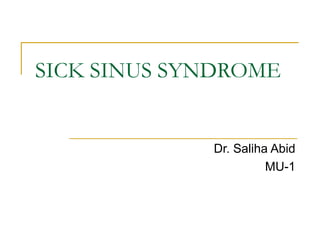
Sick sinus syndrome
- 1. SICK SINUS SYNDROME Dr. Saliha Abid MU-1
- 2. Definition: Sick sinus syndrome describes dysfunction of the intrinsic pacemaker of the heart, the sinoatrial node. As a result, the heart rhythm becomes abnormal characterized by: Sinus bradycardia -- slow heart rates Tachycardias -- fast heart rates Bradycardia-tachycardia -- alternating slow and fast heart rhythms
- 3. Mechanism: Normally, the sinus node produces a steady pace of regular electrical impulses. In sick sinus syndrome, these signals are abnormally paced. A person with sick sinus syndrome may have heart rhythms that are too fast, too slow, punctuated by long pauses — or an alternating combination of all of these rhythm problems.
- 4. Types and Causes: Types of sick sinus syndrome and their causes include: Sinoatrial block. Electrical signals move too slowly through the sinus node, causing an abnormally slow heart rate. Sinus arrest. The sinus node activity pauses. Tachycardia-bradycardia syndrome. The heart rate alternates between abnormally fast and slow rhythms, often with a long pause (asystole) between heartbeats
- 5. Sick sinus syndrome is relatively uncommon. It may be brought on by the use of certain drugs: such as digitalis, calcium channel blockers, betablockers, and anti-arrhythmics. Sick sinus syndrome usually occurs in people older than 50, in whom the cause is often a nonspecific, scar-like degeneration of the heart's conduction system like amyloidosis, sarcoidosis, Chagas disease and cardiomyopathies. In children, a common cause of sick sinus syndrome is heart surgery, especially on the upper chambers. Coronary artery disease, high blood pressure, and aortic and mitral valve diseases may be associated with sick sinus syndrome.
- 6. Symptoms: Most people with sick sinus syndrome initially have few or no symptoms. In some cases, symptoms may come and go. When they do occur, sick sinus syndrome symptoms may include: Slower than normal pulse (bradycardia) Fatigue Dizziness or lightheadedness Fainting or near-fainting Shortness of breath Chest pains Trouble sleeping Confusion Palpitations Many of these signs and symptoms are caused by reduced blood flow to the brain
- 7. ECG manifestations: Sick sinus syndrome can produce a variety of ECG manifestations consisting of atrial bradyarrhythmias, atrial tachyarrhythmias, and alternating bradyarrhythmias and tachyarrhythmias. Supraventricular bradyarrhythmias may include sinus bradycardia, sinus arrest with or without junctional escape, ectopic atrial bradycardia, and atrial fibrillation with slow ventricular response. The sino-atrial exit block that occurs in patients with sick sinus syndrome may demonstrate a Mobitz type I block and a Mobitz type II block. The ECG may reveal a long pause following cardioversion of atrial tachyarrhythmias, and a greater-than three-second pause following carotid massage. Sixty percent of patients have tachyarrythmias.
- 8. Treatment: Treatment may not be necessary if you do not have any symptoms. A permanent implanted pacemaker may be needed if your symptoms are related to bradycardia (slow heart rate). A fast heart rate (tachycardia) may be treated with medications. Sometimes radiofrequency ablation is used to cure tachycardia.
- 9. HEART BLOCKS Interference with the conduction process of the heart causes the phenomena called "heart block" or "AV block." Heart block is classified according to the level of impairment — first-degree heart block, second-degree heart block or third-degree (complete) heart block.
- 10. FIRST DEGREE HEART BLOCK On an electrocardiogram (ECG), the PR interval is defined as the time interval between the initial deflection of the P wave to the start of the QRS complex. Normally, this interval should be between 120 and 200 msec. First-degree heart block, or first-degree atrioventricular (AV) block, is defined as prolongation of the PR interval on the ECG to more than 200 msec. First-degree heart block is considered "marked" when the PR exceeds 300 msec. While the conduction is slowed, there are no missed beats.
- 11. Causes: The following are the most common causes of first-degree atrioventricular (AV) block: Intrinsic AV nodal disease Enhanced vagal tone Acute MI, particularly acute inferior wall myocardial infarction (MI) Myocarditis Electrolyte disturbances (eg, hypokalemia, hypomagnesemia) Drugs (especially those drugs that increase the refractory time of the AV node, thereby slowing conduction)
- 12. Drugs that most commonly cause first-degree AV block include the following: Class Ia antiarrhythmics (eg, quinidine, procainamide, disopyramide) Class Ic antiarrhythmics (eg, flecainide, encainide, propafenone) Class II antiarrhythmics (beta-blockers) Class III antiarrhythmics (eg, amiodarone, sotalol, dofetilide, ibutilide) Class IV antiarrhythmics (calcium channel blockers) Digoxin or other cardiac glycosides Magnesium
- 13. Pathophysiology: With first-degree atrioventricular (AV) block, every atrial impulse is transmitted to the ventricles, resulting in a regular ventricular rate. This type of AV block can arise from delays in the conduction system in the AV node itself, the His-Purkinje system, or a combination of both. Overall, dysfunction at the AV node is much more common than dysfunction at the His-Purkinje system. If the QRS complex is of normal width and morphology on the ECG, then the conduction delay is almost always at the level of the AV node. If, however, the QRS demonstrates a bundle-branch morphology, then the level of the conduction delay is often localized to the His-Purkinje system.
- 14. Diagnosis: It is usually an incidental finding on a routine ECG. This is seen as a PR interval greater than 200 ms in length on the surface ECG.
- 15. Clinical Findings: History: Generally asymptomatic at rest Markedly prolonged PR interval may reduce exercise tolerance in some patients. Syncope may result from transient high degree AV block. Past history of heart disease including myocarditis or MI Patients may be highly conditioned athletes History of infections such as lyme disease
- 16. Physical Findings: The intensity of the first heart sound is decreased in patients with first degree AV block. Patients may have a short, soft, blowing, diastolic murmur heard at the cardiac apex
- 17. Treatment: No specific therapy is indicated for isolated first degree A|V block. Management usually includes identifying and correcting electrolyte imbalances and withholding any offending medications. Any associated condition should be treated appropriately
- 18. Thank You
